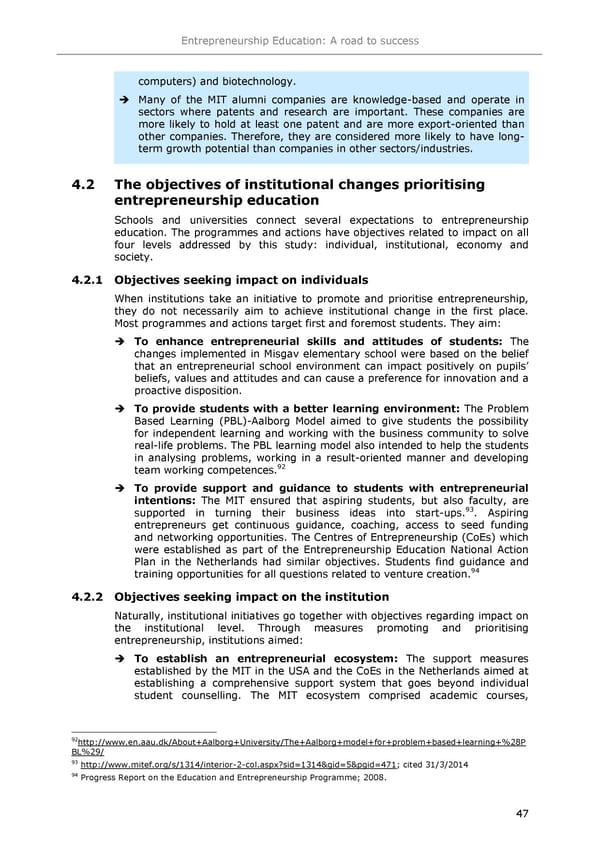Entrepreneurship Education: A road to success computers) and biotechnology. Many of the MIT alumni companies are knowledge-based and operate in sectors where patents and research are important. These companies are more likely to hold at least one patent and are more export-oriented than other companies. Therefore, they are considered more likely to have long- term growth potential than companies in other sectors/industries. 4.2 The objectives of institutional changes prioritising entrepreneurship education Schools and universities connect several expectations to entrepreneurship education. The programmes and actions have objectives related to impact on all four levels addressed by this study: individual, institutional, economy and society. 4.2.1 Objectives seeking impact on individuals When institutions take an initiative to promote and prioritise entrepreneurship, they do not necessarily aim to achieve institutional change in the first place. Most programmes and actions target first and foremost students. They aim: To enhance entrepreneurial skills and attitudes of students: The changes implemented in Misgav elementary school were based on the belief that an entrepreneurial school environment can impact positively on pupils9 beliefs, values and attitudes and can cause a preference for innovation and a proactive disposition. To provide students with a better learning environment: The Problem Based Learning (PBL)-Aalborg Model aimed to give students the possibility for independent learning and working with the business community to solve real-life problems. The PBL learning model also intended to help the students in analysing problems, working in a result-oriented manner and developing 92 team working competences. To provide support and guidance to students with entrepreneurial intentions: The MIT ensured that aspiring students, but also faculty, are 93 supported in turning their business ideas into start-ups. . Aspiring entrepreneurs get continuous guidance, coaching, access to seed funding and networking opportunities. The Centres of Entrepreneurship (CoEs) which were established as part of the Entrepreneurship Education National Action Plan in the Netherlands had similar objectives. Students find guidance and training opportunities for all questions related to venture creation.94 4.2.2 Objectives seeking impact on the institution Naturally, institutional initiatives go together with objectives regarding impact on the institutional level. Through measures promoting and prioritising entrepreneurship, institutions aimed: To establish an entrepreneurial ecosystem: The support measures established by the MIT in the USA and the CoEs in the Netherlands aimed at establishing a comprehensive support system that goes beyond individual student counselling. The MIT ecosystem comprised academic courses, 92 http://www.en.aau.dk/About+Aalborg+University/The+Aalborg+model+for+problem+based+learning+%28P BL%29/ 93 http://www.mitef.org/s/1314/interior-2-col.aspx?sid=1314&gid=5&pgid=471; cited 31/3/2014 94 Progress Report on the Education and Entrepreneurship Programme; 2008. 47
 Entrepreneurship Education Page 50 Page 52
Entrepreneurship Education Page 50 Page 52